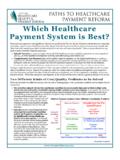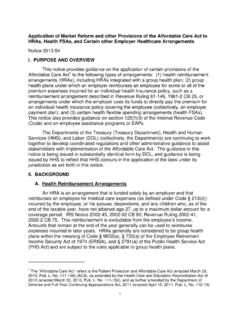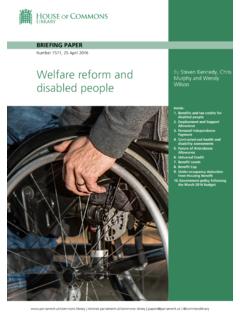Transcription of Roadmap for Implementing Value Driven Healthcare in the ...
1 Centers for MediCare & MediCaid serviCesRoadmap for Implementing Value Driven Healthcare in the Traditional Medicare Fee-for-Service ProgramGOALS FOR Value -BASED PURCHASING: Financial Viability where the financial viability of the traditional Medicare fee-for-service program is protected for beneficiaries and taxpayers. Payment Incentives where Medicare payments are linked to the Value (quality and efficiency) of care provided. Joint Accountability where physicians and providers have joint clinical and financial accountability for Healthcare in their communities. Effectiveness where care is evidence-based and outcomes- Driven to better manage diseases and prevent complications from them.
2 Ensuring Access where a restructured Medicare fee-for-service payment system provides equal access to high quality, affordable care. Safety and Transparency where a Value based payment system gives beneficiaries information on the quality, cost, and safety of their Healthcare . Smooth Transitions where payment systems support well coordinated care across different providers and settings. Electronic Health Records where Value Driven Healthcare supports the use of information technology to give providers the ability to deliver high quality, efficient, well coordinated FOR AMERICA: Patient-centered, high quality care delivered efficiently. Table of Contents 1 Vision, Goals and Objectives.
3 1 Purpose of This Paper .. 4 Requirements for Implementing VBP in the Medicare FFS Program .. 4 Roadmap and Current Work in Implementing VBP in the Major Medicare FFS 5 Identifying and Promoting the Use of Quality Measures through Pay-for-Reporting .. 5 Hospital IPPS .. 5 Physicians .. 6 Home Health .. 7 Paying for Quality Performance .. 8 Hospitals: Premier 8 Developing and Using Measures of Physician and Provider Resource Use .. 9 Internal 9 MIPPA Implementation .. 9 Paying for Value : Promoting Efficiency in Resource Use While Providing High Quality Care ..10 HACs and Present on Admission Indicator Reporting ..10 Hospital VBP Plan Physician VBP Plan Development.
4 12 Payment for ESRD Patients ..12 Physician: PGP Home Health Pay-for-Performance Demonstration ..14 Nursing Home VBP Medical Home Promoting Better Alignment of Financial Incentives Among Providers ..16 Proposed Exception to the Physician Self-referral Rules ..17 Medicare Hospital Gain-sharing Demonstration ..17 Table of Contents, continued Physician Hospital Collaboration Demonstration ..17 Acute Care Episode (ACE) Post Acute Care (PAC) Payment Reform Fostering Transparency and Public Reporting ..19 Compare Site Reporting Upgrades/Star Rating Chartered Value Exchanges (CVEs)..21 Implementing and Adopting EHRs and Health Information E-Prescribing Incentive EHR Demonstration.
5 22 PHR Choice Pilot ..23 Next Steps for Implementing VBP in the Medicare FFS Payment for ESRD Hospital VBP Plan Physician VBP Plan PAC Payment Reform Promote Better Alignment of Financial Incentives Among Conclusion ..25 Attachment: Currently Identified Factors to be Considered for Implementing VBP in the Medicare FFS Program ..27 Introduction Given that CMS policies have a transformative impact on the health care system, it is important to develop the tools necessary to create rational approaches to lessen Healthcare cost growth and to identify and encourage care delivery patterns that are not only high quality, but also cost-efficient. To help address these concerns, CMS during the current Administration and with direction from Congress ( , through enactment of provisions in the Medicare Modernization Act, Deficit Reduction Act, and other provisions) has begun to transform itself from a passive payer of services into an active purchaser of higher quality, affordable care.
6 Further future efforts to link payment to the quality and efficiency of care provided, would shift Medicare away from paying providers based solely on their volume of services. The catalyst for such change would be grounded in the creation of appropriate incentives encouraging all Healthcare providers to deliver higher quality care at lower total costs. This is the underlying principle of Value -based purchasing (VBP). The cornerstones of VBP are the development of a broad array of consensus-based clinical measures, effective resource utilization measurement, and the payment system redesign mentioned above. The overarching goal would be to foster joint clinical and financial accountability in the Healthcare system.
7 This paper contains an inventory and status of key projects, programs and demonstrations that currently support such a transformation. It also provides CMS and other policy-makers with a Roadmap , having a 3 to 5 year time frame, for restructuring the major Medicare fee-for-service (FFS) payment systems utilizing the principles of VBP. This Roadmap is focused on completion of ongoing activities including implementation of requirements found in DRA and MIPPA, completion of open comment periods in the regulatory process, and completion of key demonstration programs that would be critical to Implementing VBP in the current payment systems. Vision, Goals and Objectives Achieving transformation to achieve Value for Medicare is not something that CMS can or should do by itself.
8 It is possible that new legislation will be needed to permit certain restructuring of physician/provider relationships as well as payment system changes. CMS would need to work in partnership with physicians, providers, beneficiaries, Congress, and other stakeholders to create a Healthcare financing system that promotes joint clinical and financial accountability. Physicians and providers would need to reorganize themselves in order to achieve the best clinical and financial outcomes. And CMS would need to restructure the payment systems in order to provide incentives for physicians and providers to work together to develop new ways to deliver high quality, efficient care while maintaining beneficiary access.
9 The road to VBP would begin by working within the currently established payment structure. Incentive payments for quality reporting and performance, efficiency, and eventually Value would need to be developed and incorporated into the current payment systems, which encompass hospital, physician, skilled nursing facilities (SNFs), and other provider types and settings. 1 Provider-based quality incentive and shared savings programs could increase the provider communities understanding and appreciation of the need to have joint accountability in their clinical and financial outcomes. This could support further development and expansion of accountable care organizations (ACOs), which are collaborations between physicians, hospitals, and all providers that will be clinically and financially accountable for Healthcare delivery in their communities.
10 Members of these ACOs would share a common goal to improve quality and decrease costs in their communities. Large payers, including Medicare, could help these collaborations form by providing quality and cost information for the populations they serve. ACOs could also interact with CMS in VBP payment models that could incorporate principles of competitive bidding for services, shared savings, or payment differentials based on performance. CMS has already begun to pay for reporting of quality data for hospitals, HHAs, and physicians. As additional pay-for-performance payment strategies are established, CMS would need to provide tools to providers, based on work currently in progress, that would enable them to measure and monitor resource use and costs.

















